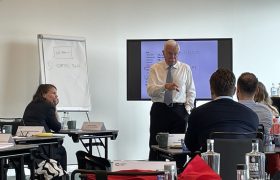Achieving value creation in M&A: three views

The first, obvious question that was put on the table was of course what value creation exactly is for our three panel members. Value creation is often viewed as the ultimate goal in any M&A transaction. However, it’s more an outcome of doing several things right rather than a standalone objective. All three experts underscored that value creation varies significantly from one company to another. Some businesses might achieve this through innovation, others via expansion into new markets, and some by enhancing their operational efficiency.

Koen Hoffman, CEO of Value Square, explained that his firm even has a yearly Value Creation Award. “Which is nothing more than a meticulous analysis of equity components, adjusted for dividends and capital changes to rank companies by their value creation over a decade. We measure value creation by carefully analyzing the equity components and adjusting for dividends and capital changes. This allows us to rank companies by their value creation over ten years.” This approach emphasizes the belief that consistent, well-rounded performance across various parameters inevitably leads to value creation.
Muriel Uytterhaegen, a partner at We Are Jane, shared insights from her venture capital experience, noting that value creation plans are tailored case by case. “Before investing, we conduct thorough analyses to identify strengths and potential risks, crafting a roadmap for value creation that aligns with the unique needs of each company,” she explained. Uytterhaegen’s approach highlights the need for a deep understanding of each company’s specific context and challenges, ensuring that the value creation strategy is both realistic and achievable.
Edwig Tanghe, founder and partner at Resolvus, highlighted a different aspect of value creation, focusing on the importance of separating the roles of shareholders and operational managers. He stressed, “financial issues are often symptoms of deeper organizational problems, which need addressing to foster long-term value creation.” Tange’s perspective suggests that beyond financial metrics, organizational health and clarity in roles are crucial for sustained success.
Leadership
Leadership is pivotal in ensuring value creation post-merger. Effective leaders are not just charismatic but also authentic, with a clear vision and strong communication skills. The organizational chart, both current and future, should consist of well-defined roles and responsibilities to avoid confusion and ensure smooth integration.
Edwig Tanghe pointed out that during times of financial trouble, leaders must look beyond immediate issues and focus on long-term goals. “Leaders need to make tough decisions and communicate them clearly to all stakeholders. Authenticity and transparency are key. Employees and other stakeholders need to believe in the leader’s vision and trust their intentions”, he says. This highlights the importance of trust and credibility, which can only be built through consistent and honest communication.
Muriel Uytterhaegen added that involving key stakeholders, including employees, customers, and suppliers, is crucial for a successful integration. At Accent and House of HR, two companies founded by Conny Vandendriessche, who is also involved in We Are Jane, key people are made shareholders to align their interests with the company’s goals, fostering a sense of ownership and commitment. This strategy not only aligns incentives but also empowers employees to contribute actively to the company’s success, enhancing overall buy-in and commitment. “Making key employees shareholders aligns their interests with the company’s goals, fostering a sense of ownership and commitment”, she noted. This practice can be particularly effective in retaining top talent and maintaining morale during the often-tumultuous period following a merger.
Post-merger integration
Muriel Uytterhaegen also addressed the matter of post-merger integrations. “The company I know best is House of HR. They don’t believe in integration, they are a house of brands. They leave each company stand alone. Of course, you can share certain services, but each company has its own DNA and its own customers that come there for a certain reason. And it’s hard to oblige them to go in a certain way.”
Edwig Tanghe noted that cultural compatibility between companies is quite difficult to assess in the due diligence. “Culture is so many things, from the way you organize meetings to the way you address people. You should walk the floor and try to feel it. It’s very important but very hard to involve in the due diligence.”
“Do you know how Katoennatie integrates companies?”, Koen Hoffman asked the audience. “Fernand Huts takes everyone and their partners a week to Venice and they eat and drink and party. If you get different people to eat and drink and laugh, they will get along and share knowledge. On a different note: I would work with the smallest number of advisors as possible. Why? Because you need to have the knowledge to due diligence something in your own company. If you have to do it externally, selling it to your own people will be so much more difficult.”

Pitfalls
One of the common pitfalls in M&A is rushing into decisions without thorough analysis. Koen Hoffman cautioned against being swayed by compelling presentations that promise synergies without substantial evidence. He advocates for maintaining a list of potential targets and engaging in proactive discussions about them to avoid last-minute, high-pressure decisions. Measuring the success of an M&A deal is equally important, but also complex. Long-term success requires a deeper analysis. Short-term metrics, such as quarterly earnings or stock price movements, can provide an incomplete and sometimes misleading picture of a merger’s success. These metrics can be influenced by one-time events or accounting practices that do not reflect the underlying health of the business. In contrast, long-term metrics like cash return on investment, market share growth, and customer retention rates offer a more comprehensive view of how well the merged entity is performing.
Hoffman highlighted that at Value Square, they look at cash return on investment as a key metric, which provides a more accurate picture of the merger’s financial health and sustainability. “We focus on cash return on investment, which provides a clearer picture of long-term success”, he explained.
Muriel Uytterhaegen echoed this sentiment, emphasizing that private equity investors need to focus on long-term value creation. This involves continuous monitoring and adjustment of strategies to ensure that the company remains on track to achieve its goals. “Long-term value creation requires continuous monitoring and strategic adjustments.”
“I think in the short term, it is for instance about the fact that any key people have left the company. Do the IT systems integrate well? What’s the reaction of the stakeholders?”, Edwig Tanghe sums up. “In the long term, it’s creating the value which was in the plan and the reason for acquiring the company.”
Artificial intelligence
This being a discussion in 2024, the trio also tapped into the possibilities of technology driving value in the M&A, and specifically of course artificial intelligence. “I think it can definitely help in the due diligence process”, says Edwig Tanghe. “You know, looking at market shares and in making simulations and scenarios.”
Koen Hoffman on the other hand called AI a “negative”. “Twenty years ago, you had the back on the envelope calculations. I don’t say that is ideal, but if you have common sense and you know why you do something, you can calculate the numbers in two minutes. Virtual data rooms are terabytes in size these days. It’s like finding a needle in a haystack: it’s impossible. And the legal guys know exactly how to hide the problems or the things I don’t need to see. Now of course, artificial intelligence might actually help on finding certain stuff and trends. And it’s easier, because today you can go through all the accounts and see if you find certain things. I’m just a bit scared that the more data you get, the more difficult it might become to see the bigger picture. And you go into insignificant details, and everyone wants to find insignificant details just to show off that you found something.”
The DYI approach
Mergers and acquisitions are powerful tools for business growth and value creation, but they come with significant challenges. Successful M&A requires a combination of strategic planning, strong leadership, and effective stakeholder management. By focusing on long-term value creation, involving key stakeholders, and maintaining clear communication, companies can navigate the complex waters of M&A and emerge stronger and more resilient.
“However: one of the questions you always have to ask yourself is: can’t I do this myself”, Koen Hoffman says. “What if you were to spend the same amount of money, what do you get in return? Sure, it will take two or three years before you see results. Whereas if I spend 30 million immediately, I have some immediate results, but then three years from now, they might be very negative. Whereas if I do it myself, the chances of doing something culturally right, is going to be much better, because I’m going to do it with my own team. So they’re already all involved. They’re all shoulder to shoulder. They all know that it must work.”

Take a look at the pictures here.
Thank you SS&C Intralinks for sponsoring the M&A Forum and
Thank you Simont Braun for hosting the event.








